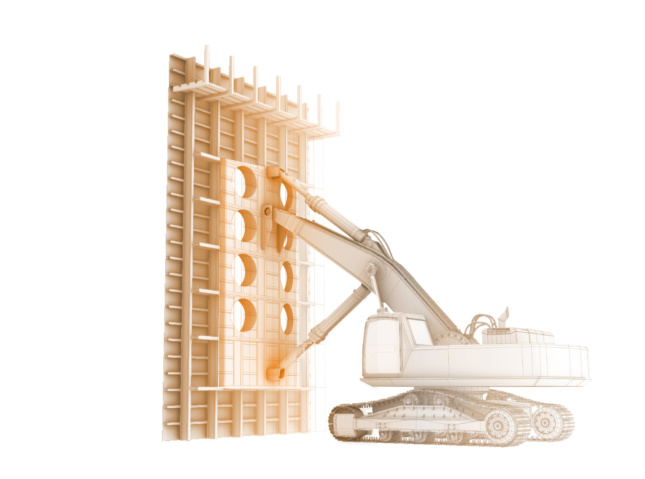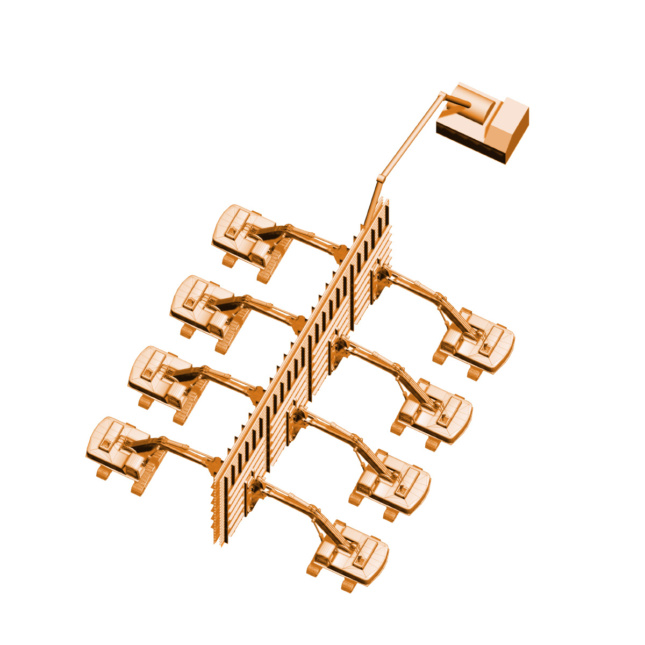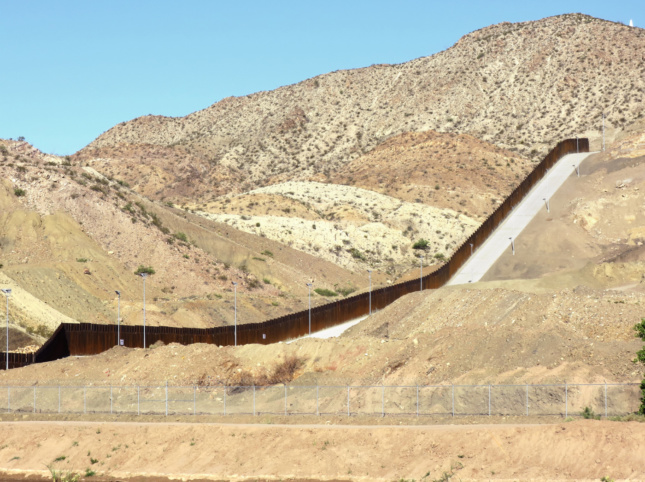Over ten days this past spring, a privately funded group named We Build the Wall hurriedly constructed a segment of the proposed United States–Mexico border wall in Sunland Park, New Mexico. The rapid erection of this so-called “gift to America” shocked nearby communities and the project served as a startling proof of concept for emerging wall construction technologies. Developed under the auspices of the Trump administration’s border wall request for proposals, these are the products of a technological arms race to improve the speed and efficiency in which national security infrastructure can be delivered. The segment is the first product of what will surely become a growing list of building technologies developed as part of the xenophobic border wall project. These technologies will shape project delivery expectations, methods, and outcomes in the borderland and beyond as the building industry and the built environment inherit securocratic technologies developed in the shadow of the wall.
As construction companies attempt to curry favor with the administration, there has been an uptick in patent filings for construction systems and project delivery methods explicitly tied to border wall construction. In 2018 alone, there were three such patents filed with the U.S. Patent and Trademark Office (USPTO), including designs for a border wall built of shipping containers, a “power-generating border wall,” and a “multifunctional solar-powered barrier wall,” which included financing instruments its inventors argued would allow the wall to pay for itself.
Fisher Sand & Gravel, the North Dakota company responsible for the construction of the wall in Sunland Park, holds a patent (through its subsidiary, General Steel & Supply Company) for a proprietary “concrete forming system” designed to expedite border wall construction. Claiming the technique would allow completion of the entire border wall within six years and under budget, Fisher was one of six companies picked to build a wall prototype in Otay Mesa, California, after the Trump administration’s RFP for border barriers in 2017.

Fisher’s concrete-forming patent describes a novel process which capitalizes on modified construction equipment to rapidly form and cure extensive, continuous, cast-in-place concrete panels. At the core of the proposal are modified excavators adapted to traverse mountainous terrain equipped with “quick connect” arm couplers capable of positioning massive steel formwork. The excavators and steel forms, per the patent’s argument, eliminate the need for numerous, labor-intensive ties and bracing that more typical concrete construction would require, while also eliminating the transportation costs and potential breakage associated with positioning individual precast panels.
The steel formwork can be rotated on three axes, controlling for pitch, yaw, and roll, allowing endless adjustments in “attitude, position, and/or orientation,” in rugged borderland terrain. The flexible system allows operators to control the wall section of the barrier, facilitating wall designs of equal thickness, tapered “triangular-shaped” walls, or “any other orientation or configuration.”
Patent drawings show a veritable army of excavators choreographed to position alternating sections of steel formwork with military discipline. As the wall is poured, the edges of completed freestanding sections are incorporated as formwork for infill panels, allowing a nonstop rhythm of pouring and curing along the line. In a self-assured video extolling the virtues of its method, Fisher boasts that its wall, covering the entirety of the land border with Mexico, will protect the U.S. for 150 years to come.
A Customs and Border Protection (CBP) test team evaluated the construction of Fisher’s prototype in Otay Mesa and noted that—along with all concrete prototypes—the proposal would face “extensive” challenges in construction. Its concrete design having failed to procure the elusive border-wall contract, Fisher incorporated much of the same proprietary technology and delivery protocols into a modified steel design.
Videos online show Fisher’s technique for construction of a steel bollard fence using a similar process to the one outlined in the concrete-forming patent. Workers first prepare a trench and position a fleet of modified excavators around the site. Instead of positioning metal formwork, the vehicles are outfitted with a custom trussed hanger spanning 56 feet on which workers hang prefabricated sections of bollard fence. The vehicles then position the long sections, drop them into the trench, level and align as necessary, and fix the bollards in a poured concrete foundation.
Unlike the concrete-forming method, which requires excavators to be positioned on both sides of the fence, the steel fence can be erected with machines working from one side only. During demonstrations, the company pointed out that the construction process would not breach the international boundary.
According to Fisher, the bollard-fence hanging system is “patent-pending,” though no record of a new application from Fisher Industries or subsidiaries is yet available on the USPTO database. A remarkably similar design for a “bollard fence” was filed by Neusch Innovations in December 2018 and may be related.

Company executive Tommy Fisher relentlessly promoted Fisher’s steel design as a faster, cheaper, and better alternative to other techniques, a bold triad of claims given the realities of the construction industry. The Republican donor has aggressively targeted this message to conservative outlets like Fox News, largely gaining the support of border wall advocates, and even Trump himself, whose fervor for the wall Fisher consistently praises. Trump has allegedly tried repeatedly to influence the public bid process by pushing the U.S. Army Corps of Engineers (USACE) to award Fisher the contract, as yet to no avail. Fisher, meanwhile, has demonstrated his construction technique to politicians in Arizona, claiming the tests prove his company capable of building 218 miles of the border wall in one year. Despite the USACE’s negative appraisal of the design and Department of Homeland Security officials’ negative views of the company, Fisher eventually found a partner to build the steel assembly in the privately funded, pro-wall, conservative nonprofit We Build the Wall.
Fisher construction crews descended on Sunland Park over Memorial Day weekend, armed with specially equipped excavators and prefabricated bollard steel fencing. Construction was reported complete ten days later, with about a half-mile of barrier constructed in the formerly pristine environment.
The shocking speed of construction, enabled by Fisher’s proprietary methods and equipment, obscured the project’s significant damage. The new border wall, although built on private property, abuts federal property, and its locked gate blocked entry to the American Diversion Dam, a critical piece of national infrastructure. The International Boundary and Water Commission, the agency that manages waterways on the U.S.–Mexico border, has ordered the gate to remain open to allow for operations and maintenance at the dam.

Additionally, to create a relatively horizontal cross-section for the border fence appropriate for the company’s method, Fisher filled an existing deep arroyo with 200,000 cubic yards of soil. The effects of this extensive terraforming within a fragile desert ecology are unknown, as the company did not perform an environmental impact assessment. Scientists speculate that much of the disturbed soil was heavily polluted from nearby industry and will precipitate into the Rio Grande, sending more pollutants downstream, mostly into Mexican farms.
While we as architects might resist the border wall itself, we must also respond to the myriad advances in the construction industry which have matured in its wake. Efficiencies must not be gained at the expense of human dignity or lives.











